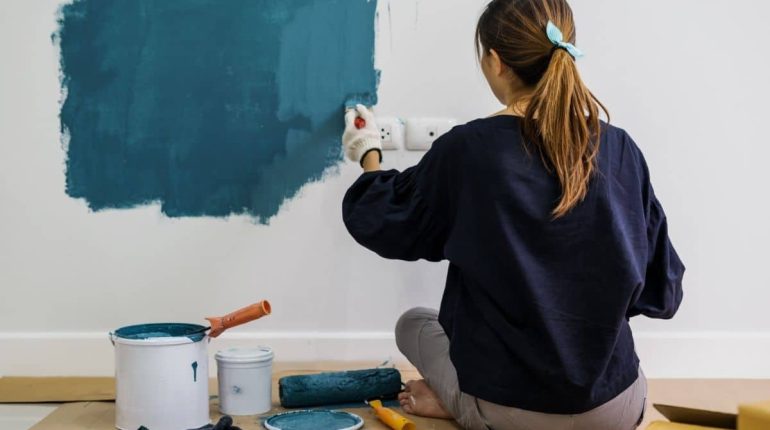
Everyone makes mistakes. It’s a fact of life.
And, this is especially true when it comes to house painting.
While a fresh coat of paint can spruce up your home, it’s not an easy task. Sure, professional painters and DIY-ers make it look easy, but it’s important to understand some of the most common mistakes people make when painting their homes to ensure that you don’t make them too.
You’ll probably be surprised to know that the most common mistakes when it comes to house painting don’t actually happen during the painting process, but in the painting preparation stage. These minor oversights can lead to much bigger issues down the line, which is why we have compiled a list of the top 10 painting mistakes everybody makes and how to fix them.
So, before you reach for that paint brush, give this comprehensive guide a read to ensure the best painting results every time.
 If you’re looking to paint your home with the same professional finish as a pro, then you’ll need to ensure you include painter’s tape in your painting artillery.
Applying painter’s tape to the corners or the wall, ceiling, light fixtures, doors, skirting board and window frames will ensure that you leave your edges looking crisp and give you those sharp lines. It will also protect important surfaces from potential streaks and splashes if you don’t always have a steady hand with your paint brush or roller.
If you’re looking to paint your home with the same professional finish as a pro, then you’ll need to ensure you include painter’s tape in your painting artillery.
Applying painter’s tape to the corners or the wall, ceiling, light fixtures, doors, skirting board and window frames will ensure that you leave your edges looking crisp and give you those sharp lines. It will also protect important surfaces from potential streaks and splashes if you don’t always have a steady hand with your paint brush or roller.
 Overbrushing, or brushing over the same area even after the paint has started drying, is a common mistake usually made by novice painters.
Applying too much paint to a wall, or aimless brushing, can cause visible ridges and lines to appear on the surface. For a smooth, professional finish, it’s important to know when to say when and stop painting until your paint is dry. Only then, can you potentially apply another coat without creating uneven results.
Overbrushing, or brushing over the same area even after the paint has started drying, is a common mistake usually made by novice painters.
Applying too much paint to a wall, or aimless brushing, can cause visible ridges and lines to appear on the surface. For a smooth, professional finish, it’s important to know when to say when and stop painting until your paint is dry. Only then, can you potentially apply another coat without creating uneven results.
 Paint doesn’t deal with extreme weather conditions very well, so be sure to check the forecast before starting a fresh paint job – especially if you’re painting outside.
On one hand, extreme heat may make your paint bubble or crack, leaving you with uneven results. While cold and damp conditions will make it difficult for the paint to adhere and dry evenly, leading to eventual cracking and flaking.
Paint doesn’t deal with extreme weather conditions very well, so be sure to check the forecast before starting a fresh paint job – especially if you’re painting outside.
On one hand, extreme heat may make your paint bubble or crack, leaving you with uneven results. While cold and damp conditions will make it difficult for the paint to adhere and dry evenly, leading to eventual cracking and flaking.
1.Not using painter’s tape
 If you’re looking to paint your home with the same professional finish as a pro, then you’ll need to ensure you include painter’s tape in your painting artillery.
Applying painter’s tape to the corners or the wall, ceiling, light fixtures, doors, skirting board and window frames will ensure that you leave your edges looking crisp and give you those sharp lines. It will also protect important surfaces from potential streaks and splashes if you don’t always have a steady hand with your paint brush or roller.
If you’re looking to paint your home with the same professional finish as a pro, then you’ll need to ensure you include painter’s tape in your painting artillery.
Applying painter’s tape to the corners or the wall, ceiling, light fixtures, doors, skirting board and window frames will ensure that you leave your edges looking crisp and give you those sharp lines. It will also protect important surfaces from potential streaks and splashes if you don’t always have a steady hand with your paint brush or roller.
Some of the top tips for using painter’s tape include:
- Make sure the surface is clean before applying the painter’s tape
- Don’t remove the tape until the paint has completely dried
- Ensure the tape is tightly sealed along surface edges.
2. Not preparing the walls for painting
Although it can be tempting just to dive in and slap a fresh coat of paint straight onto the wall, it’s always best to properly prep the wall before doing so. Properly preparing your walls for painting will ensure the best results and will help your paint to last longer. You may think that you can cover dirt and dust with paint, but the truth is that it will show right through, so make sure you give your walls a proper scrub with a damp sponge and some sugar soap. The same holds true for any cracks or holes in the wall. Before you paint, make sure that you fill any holes and sand down blemishes on the wall to ensure that the surface is smooth and ready to be primed.3. Using the wrong paintbrush
It’s often said that “a good craftsman never blames his/her tools,” but when it comes to poor paint work, this could be the case. If you ever find yourself struggling with your paint work, then it could be because you’re using the wrong paint brush or roller. For example, using water-based latex paint with a natural-bristle brush wll cause bristles that are limp to soak up the water in the paint, making the paint almost impossible to spread out. Therefore, the type of paint you are using will determine the type of brush you should use for the best results. Natural-bristle brushes work best with oil-based paints, while synthetic brushes, made from nylon or polyester, should be used when working with water-based latex paint.4. Forgetting to test the paint colour beforehand
Test paint pots were created for a reason. We advise that you always use them for this purpose and make sure they are the right match for your surface before you go ahead and paint the entire thing. House paint rarely looks the same on your walls as it did on the tin, so this is the best time to see how it suits your walls and the room. So, paint the samples directly onto your wall and see how it saturates the surface. Consider doing this on multiple walls, as the same paint may look very different depending on factors, like lighting and size. There’s nothing worse than painting an entire wall and then realising you’ve used the wrong paint, or that it doesn’t look how you expected, so save yourself the headache by testing the paint beforehand.5. Overbrushing
 Overbrushing, or brushing over the same area even after the paint has started drying, is a common mistake usually made by novice painters.
Applying too much paint to a wall, or aimless brushing, can cause visible ridges and lines to appear on the surface. For a smooth, professional finish, it’s important to know when to say when and stop painting until your paint is dry. Only then, can you potentially apply another coat without creating uneven results.
Overbrushing, or brushing over the same area even after the paint has started drying, is a common mistake usually made by novice painters.
Applying too much paint to a wall, or aimless brushing, can cause visible ridges and lines to appear on the surface. For a smooth, professional finish, it’s important to know when to say when and stop painting until your paint is dry. Only then, can you potentially apply another coat without creating uneven results.
6. Using the wrong paint
There are many types of paints, which is why it’s easy to get confused and buy the wrong type for your needs. It’s important to do your research before you just go into your local Bunnings and grab the first pot of paint you see. It’s important to consider what and where in your home you’ll be painting, as some paints are suitable for outdoors, while others can only be used indoors. If you’re painting damp rooms, like the bathroom, then it will also need its only special type of paint that won’t sweat or run from the steam. When in doubt, consult a professional to ask for advice as to which paint you should use – as using the wrong paint can be a costly and time-consuming mistake to make.7. Skipping the primer
Once you’ve prepped the wall for painting, this means that it’s ready to prime. Often people get very-excited and want to skip straight to the painting, but we always suggest that you don’t skip the primer. It’s an essential part of creating a long-lasting, smooth finish and will help to bring out the paint colour by sealing in the paint to the surface and helping the pigment better stick to your walls.8. Ignoring the weather forecast
 Paint doesn’t deal with extreme weather conditions very well, so be sure to check the forecast before starting a fresh paint job – especially if you’re painting outside.
On one hand, extreme heat may make your paint bubble or crack, leaving you with uneven results. While cold and damp conditions will make it difficult for the paint to adhere and dry evenly, leading to eventual cracking and flaking.
Paint doesn’t deal with extreme weather conditions very well, so be sure to check the forecast before starting a fresh paint job – especially if you’re painting outside.
On one hand, extreme heat may make your paint bubble or crack, leaving you with uneven results. While cold and damp conditions will make it difficult for the paint to adhere and dry evenly, leading to eventual cracking and flaking.
9. Using water-based paint on wallpaper
Painting over wallpaper is no more difficult than painting on any other wall, but there is one exception. Water-based paints and primers can often reactivate wallpaper glue, which causes it to bubble up or peel off, leaving you with an uneven surface. Instead, when painting over wallpaper it’s always recommended to use an oil-based primer to prevent any problems with proper adhesion and ensure smooth results.10. Getting paint on the ceiling
Not everybody is Michelangelo with a paintbrush, which means that there will be mistakes from time to time. Even the most skilled painters make simple mistakes such as getting paint on the ceiling. This might sound innocent enough, except that paint on the ceiling is not easily covered up. However, there are two effective ways you can avoid getting paint on the ceiling, which include using an angled paint brush to paint on the edges of the wall and using a ceiling line tool. Painting mistakes happen. But, with our list of the top 10 house painting mistakes you can avoid some of the most common mistakes and save yourself time, money and effort. If you’d like to avoid painting altogether, then leave it to the Melbourne house painting professionals at Newline Painting. Get a quote for our 5-star house painting service and transform your home today. Our services are available in various areas around Melbourne including Flemington, Footscray, Frankston, Glen Iris, and Glen Waverley. We can help you with various interior and exterior house painting services including apartment painting, feature wall painting, fence painting, and even garage painting.
Tags house painting painting primer Wall PaintingCategories Paint






